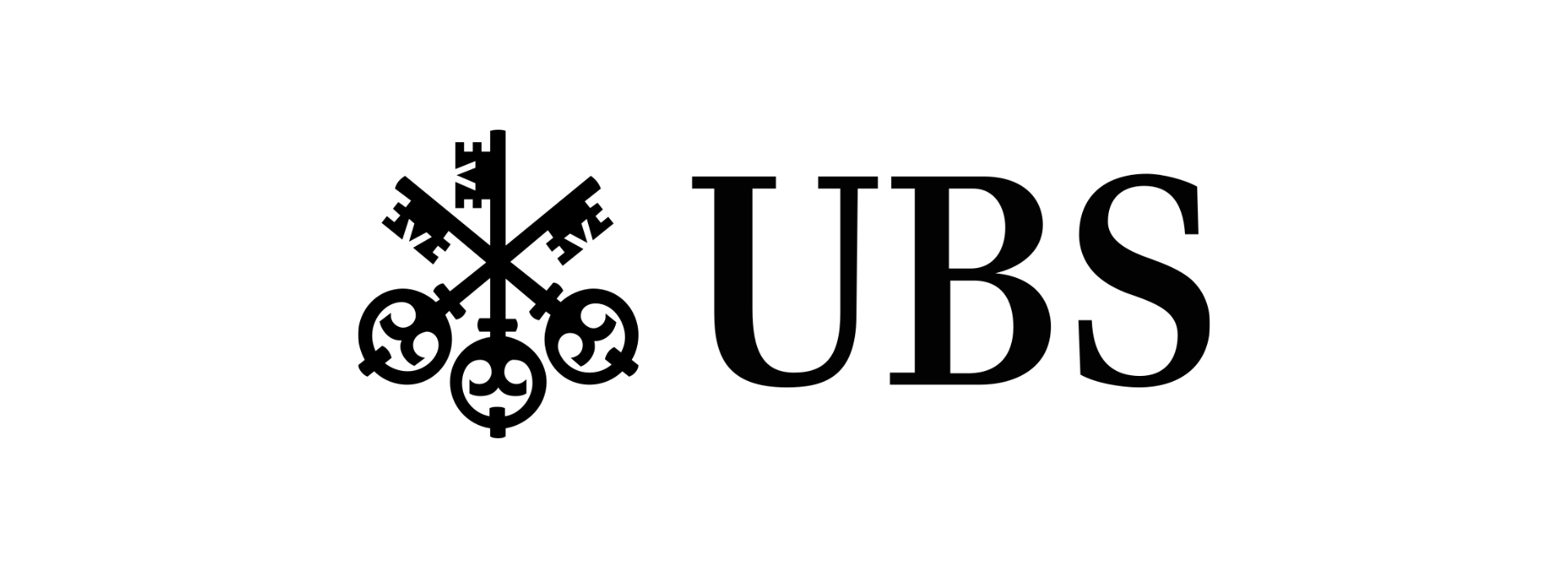Exhibitionguide
The Incredible World of Photography
The Incredible World of Photography Sammlung Ruth und Peter Herzog
18.07. – 04.10.2020
Kunstmuseum Basel | Neubau
Curators: Paul Mellenthin und Olga Osadtschy
Introduction
A serendipitous flea market find in 1974 led Ruth and Peter Herzog to begin building what has since grown into a singular photography collection encompassing over 500,000 pictures. The holdings range from the medium’s early days to the 1970s and reflect all major developments in analog photography. For the nineteenth century in particular, the two collectors made important discoveries that have deepened our understanding of the eventful history of photography. Today Ruth and Peter Herzog rank among the world’s leading photography collectors. The four hundred works chosen for the exhibition represent selected foci of the unique, vast collection. They also exemplify the sheer material diversity of photographic objects—from daguerreotypes, ambrotypes, ferrotypes, salt paper prints, and albumen paper prints to autochromes and gelatin silver prints. The range of the collection and its qualities as an “encyclopedia of life” (as Martin Heller called it in 1989) come alive in a suite of nine galleries.
Part I: Photography and the Archive
The exhibition marks the inauguration of a long-term cooperation between the Kunstmuseum Basel and the Jacques Herzog und Pierre de Meuron Kabinett, Basel, which has been the owner of the Ruth and Peter Herzog Photography Collection since 2015. In addition to providing the valuable exhibits, the Kabinett has designed an innovative exhibition architecture that was directly inspired by the setting in which the work at the Kabinett takes place and its sustained engagement with the rich spectrum of historical photography and its materiality. The design of the first four galleries of the exhibition is informed by careful considerations on the perception and presentation of the artifacts, many of which are in small formats and light sensitive. The issues raised are bourgeois studio portrait from the early days of photography (Gallery 1); the triumph of private photo albums (Gallery 2); documentary photography of contemporary events (Gallery 3); science, nature and technology (Gallery 4).
Part II: Photography and the Museum
The second chapter of the exhibition pairs the historic original photographs with major works from the Kunstmuseum Basel and treasures on loan from the Emanuel Hoffmann Foundation, including paintings by Vincent van Gogh and Robert Delaunay and works on paper by Andy Warhol, as well as photographs by Thomas Demand, John Baldessari and Bernd and Hilla Becher. The reciprocal influence of art and photography is mediated through four fundamental questions involving photography: How do painters and photographers relate to similar motivs (Gallery 6)? How does the idea of the link between original and copy change with the advent of photography (Gallery 7)? When was color photography invented, and why did “art photography” remain black-and-white for such a long time (Gallery 8)? Which forms of seriality exist in art, and which forms are characteristic for photography (Gallery 9)? These constellations draw attention to the dynamic interplay between photography and the visual arts. Visitors are invited to inquire into parallels on the levels of motifs and formal composition as well as the media’s (negotiable) boundaries.
With the eyes of Ruth and Peter Herzog
We asked the collectors: Why did specific photographs found their way into the collection? And what was their initial interest with some objects? Find the answers and short statements from Ruth and Peter Herzog here:
Room 1

Unknown, Blind woman with braille writing machine, daguerreotype
© as a collection by Jacques Herzog und Pierre de Meuron Kabinett, Basel.
1. Unknown, Blind woman with braille writing machine, daguerreotype
“The blind woman shown here with a braille-device would never have been able to view her portrait. How did she picture her outward appearance? “
Room 2

Album of Naser al-Din Shah Qajar’s court and harem, albumen prints, 1872–1875
© as a collection by Jacques Herzog und Pierre de Meuron Kabinett, Basel.
2. Album of Naser al-Din Shah Qajar’s court and harem, albumen prints, 1872–1875
“In this album with its characteristic clasp, Shah Naser al-Din of Persia proudly shows his treasures: his extensive harem photographed in tutus and little white socks, garlands carefully arranged in the album to embody his ideal of feminine beauty. The Shah emphasized his own masculinity by posing as a successful hunter and as lord and master of his court, which also included eunuchs. He gave these members of his household “amusing” nicknames such as Mastix (chewing gum).”
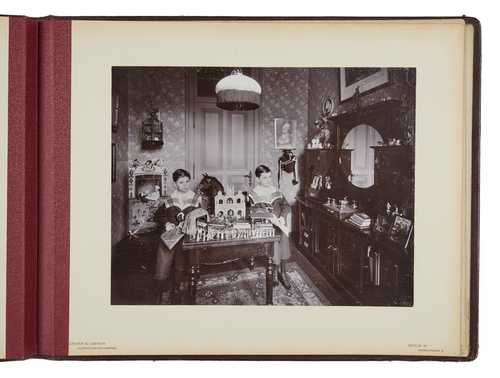
Album of a burgeois family in Berlin, Zander & Labisch, Two boys in the playroom, collodion POP, 1902 (Album: 1900–1910)
© as a collection by Jacques Herzog und Pierre de Meuron Kabinett, Basel.
3. Album of a burgeois family in Berlin, Zander & Labisch, Two boys in the playroom, collodion POP, 1902 (Album: 1900–1910)
“Inside the family album of a Berlin psychiatrist is a photo of his two sons in their playroom. Their toys make perfectly clear what roles they, as males, were expected to play. In contrast, the playroom of their sister displays typically feminine trappings such as dolls. The roles of the day envisioned for the female and male children, modeled on those of their parents, were thus already clearly defined in childhood.”
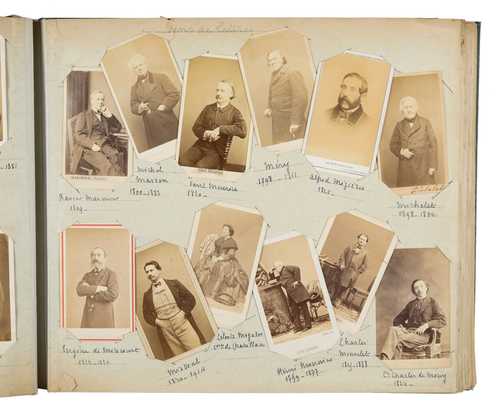
Carte de visite album from France, Pierre Petit, Charles Reutlinger, Pierre Etienne Carjat, Legé & Bergeron et al., Portraits of painters and sculptors, albumen prints, 1860–1875
© as a collection by Jacques Herzog und Pierre de Meuron Kabinett, Basel.
4. Carte de visite album from France, Pierre Petit, Charles Reutlinger, Pierre Etienne Carjat, Legé & Bergeron et al., Portraits of painters and sculptors, albumen prints, 1860–1875
“This “Mammoth Album” contains hundreds of so-called cartes de visite, photographs in nine-by-six-centimeter format. It contains a veritable who’s who of Second-Empire France: princes, generals, clergymen, musicians, painters, doctors, lawyers …
What makes this album remarkable is that these calling cards later served as mug shots for the rebels of the 1871 Paris Commune. The Communards took to the streets after France’s defeat in the Franco-Prussian War (1870–71), fighting to the bitter end against their own national troops as well as the Paris police. The conservative government was determined to prevent Paris from being governed by socialist ideals.”
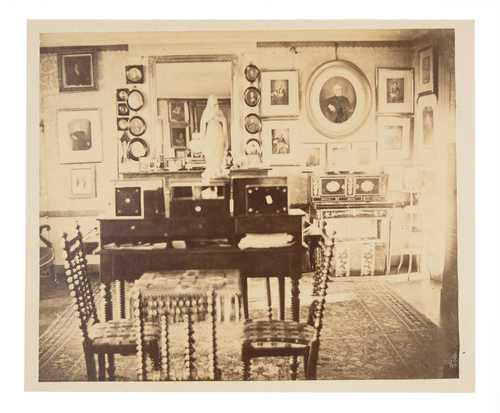
De Chazelle, Drawing room, albumen print, 1870–1895
© as a collection by Jacques Herzog und Pierre de Meuron Kabinett, Basel.
5. De Chazelle, Drawing room, albumen print, 1870–1895
“Where full-scale oil portraits once lined the halls of the palaces of nobles, the houses and apartments of the bourgeoisie were decorated instead with works of much smaller scale: silhouettes, miniatures, and even photographs.
Correspondingly smaller dwellings were the direct result of the constantly rising land prices in the burgeoning cities.”
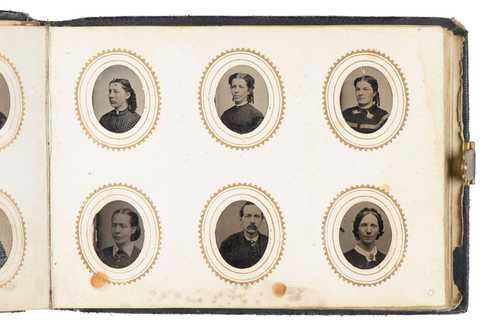
Album with studio portraits, Unknown, Portraits of women, men, and children, tintypes, 1865–1890
© as a collection by Jacques Herzog und Pierre de Meuron Kabinett, Basel.
6. Album with studio portraits, Unknown, Portraits of women, men, and children, tintypes, 1865–1890
“Photo albums come all sizes and colors and are outfitted with different features. There are family albums, travel albums, office albums—but very few presentation albums, like this one showing the work of this unknown professional photographer.
The miniscule ambrotypes, lightly colored, were probably incorporated into lockets or bracelets, serving as souvenirs of the distant beloved or dearly departed.”
Room 3
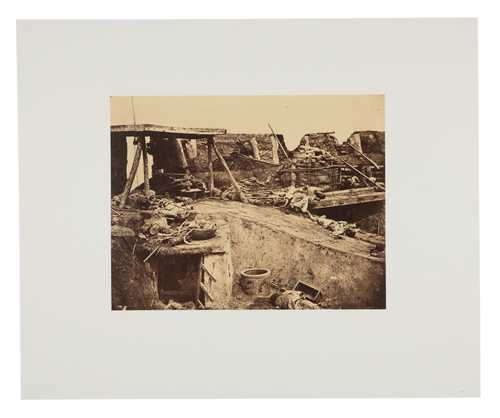
Felice Beato, After the Capture of the Taku Forts in China (Second Opium War), albumen print, 1860
© as a collection by Jacques Herzog und Pierre de Meuron Kabinett, Basel.
7. Felice Beato, After the Capture of the Taku Forts in China (Second Opium War), albumen print, 1860
“At Queen Victoria’s express request, no corpses were depicted in the first photographic war reportage: the Crimean War of 1856 (“no dead bodies allowed”). Felice Beato, however, first showed to the full extent the deadly consequences of armed conflict with this image from the Second Opium War (1860). It shows the capture and destruction by British and French troops of the powder magazine at the Taku Forts on August 21, 1860.”

Unknown, Treaty of Versailles, silver gelatin print, 1919
© as a collection by Jacques Herzog und Pierre de Meuron Kabinett, Basel.
8. Unknown, Treaty of Versailles, silver gelatin print, 1919
“This unimpressive little case contains the Treaty of Versailles, which just a short while later would bring so much woe to Europe …”

Legendre, Damaged French regimental flag, silver gelatin print, 1914-1918
© as a collection by Jacques Herzog und Pierre de Meuron Kabinett, Basel.
9. Legendre, Damaged French regimental flag, silver gelatin print, 1914-1918
“The sad tatters of a regimental flag that was once proudly presented. This convincing anti-war image says much about the pointlessness of war without showing dead bodies or ravaged cities.”

Auguste Bertsch, Micrograph of a beetles feeler (Melolonthinae), albumen print, 1853–1857
© as a collection by Jacques Herzog und Pierre de Meuron Kabinett, Basel.
10. Auguste Bertsch, Micrograph of a beetles feeler (Melolonthinae), albumen print, 1853–1857
“Auguste Bertsch photographed this maybug’s antenna through a microscope sometime between 1853 and 1854. Since the medium’s invention, photographers have tried to capture the most distant objects with the help of a telescope or, conversely, the smallest possible objects through the microscope. Bertsch was one of the pioneers of microphotography.”
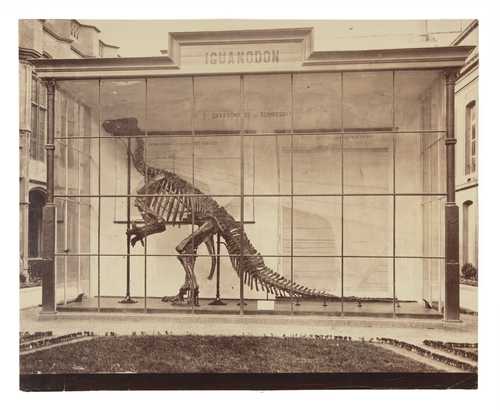
E. Ghilain-Attenelle, Skeleton of an Iguanodon in Brussels, albumen print, 1883–1890
© as a collection by Jacques Herzog und Pierre de Meuron Kabinett, Basel.
11. E. Ghilain-Attenelle, Skeleton of an Iguanodon in Brussels, albumen print, 1883–1890
“Many people, young and old alike, continue to find the world of dinosaurs mesmerizing. Imagine the fascination 150 years ago, when parts of a skeleton were found in a Belgian coal mine and it became possible to reconstruct and exhibit a complete dinosaur skeleton (Iguanodon).
Here we peer far back in time to an era when the technology of photography was still new, a time without any of the equipment that we now take for granted. Today cameras like the one used by the photographer Ghilain-Attenelle have themselves become the stuff of museum displays.”
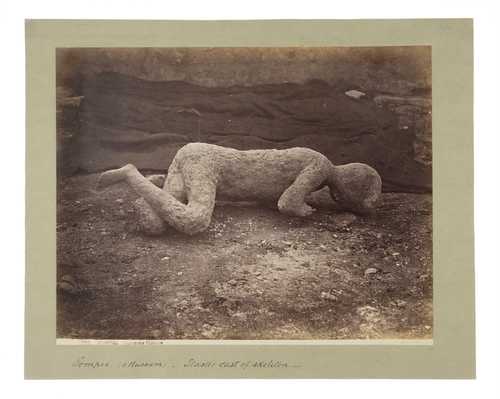
Giorgio Sommer, Cast of a child killed during the eruption of Mount Vesuvius (Pompeii), albumen print, 1882–1886
© as a collection by Jacques Herzog und Pierre de Meuron Kabinett, Basel.
12. Giorgio Sommer, Cast of a child killed during the eruption of Mount Vesuvius (Pompeii), albumen print, 1882–1886
“As Mount Vesuvius erupted, this unfortunate denizen of Pompeii sought in vain to escape the poison vapors, ash, and lava. Imprints left behind by human bodies were discovered in the cooled lava. Pouring plaster into these empty pockets made it possible to gain a vivid impression of the last moments in the lives of the doomed city’s inhabitants. Like photographs, these casts reveal snapshot-like moments that would never return.”

Léon Gimpel, Anaglyph of the moon, hand-colored silver gelatin glass plate, reproduction after the original, 1923
© as a collection by Jacques Herzog und Pierre de Meuron Kabinett, Basel.
13. Léon Gimpel, Anaglyph of the moon, hand-colored silver gelatin glass plate, reproduction after the original, 1923
“Almost as soon as it became available, Léon Gimpel began working with the autochrome process (early color photography, slides).
These images of the moon “in the first quarter, taken at the Paris Observatory between May 9, 1897 and February 7, 1900” were part of an experiment in anaglyph 3-D process.”
Room 6
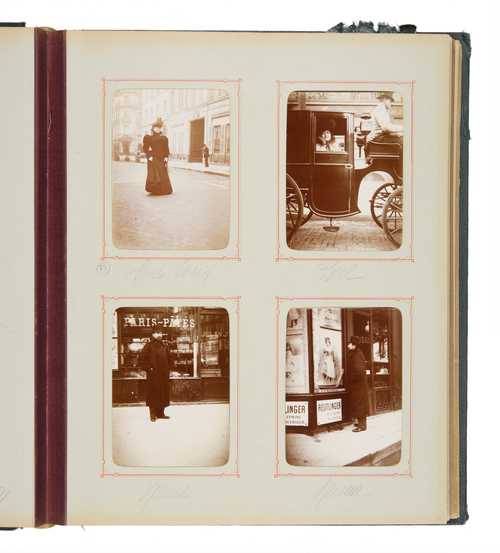
Album of Parisian artists of the Belle Epoque, l+r: Giuseppe Primoli, Parisian streets, silver gelatin POPs, 1899–1910
© as a collection by Jacques Herzog und Pierre de Meuron Kabinett, Basel.
14. Album of Parisian artists of the Belle Epoque, l+r: Giuseppe Primoli, Parisian streets, silver gelatin POPs, 1899–1910
“The privileged Count Guiseppe Primoli had access to everyone who was anyone in Society. He was thus able to take street photographs not only of all the theater and variety stars of the day but also of writers, dandies, and grandes dames. They all posed for the nobleman in the fin-de-siècle ambience of the City of Light.
These also included models for famous artists such as the celebrated actress Madame Réjane, who inspired Toulouse-Lautrec.”
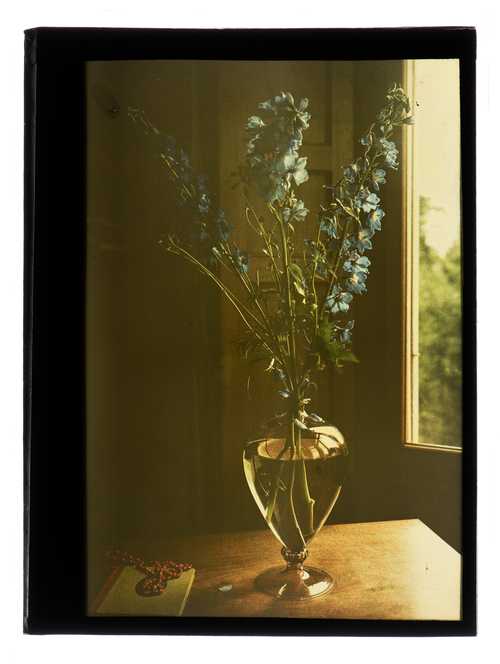
Unknown, Still lifes with flowers, autochromes, reproductions after the originals, 1907–1935
© as a collection by Jacques Herzog und Pierre de Meuron Kabinett, Basel.
15. Unknown, Still lifes with flowers, autochromes, reproductions after the originals, 1907–1935
“Thanks to their teacher, the chemist and physicist Gabriel Lippmann, the Lumière brothers were able to patent their so-called autochrome process in 1903, though the coarse-grained color slides did not come onto the market until 1907. Autochromes were enthusiastically received by a public with plenty of purchasing power. Once again the world could be conquered by photography—only this time in color.”
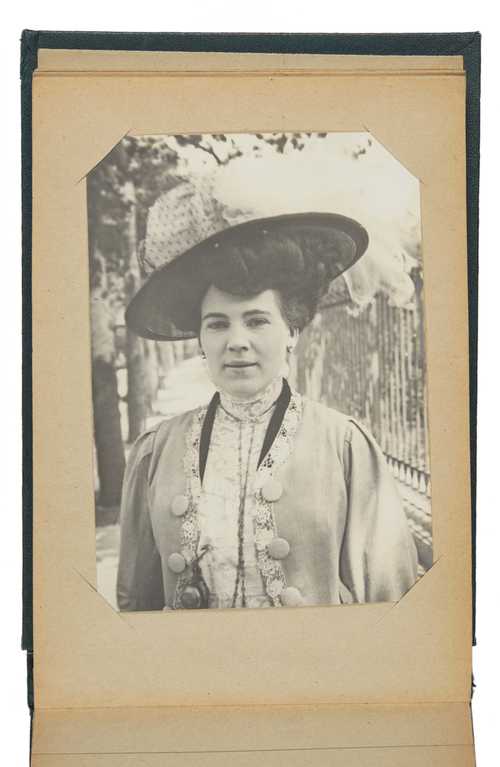
Unknown, Portraits of women and hats (from an album), silver gelatin prints, 1910–1915
© as a collection by Jacques Herzog und Pierre de Meuron Kabinett, Basel.
16. Unknown, Portraits of women and hats (from an album), silver gelatin prints, 1910–1915
“The Swiss painter and photographer Guido Sigriste developed his own cameras for extremely short exposure times. He wanted to prove that a horse moving at full gallop is actually airborne for an instant. In addition to successfully proving this, he produced his camera between 1903 and 1906. It soon found a market among reporters, since it allowed for snapshots to be taken, for example, at races of all kinds—of cars and bicycles, and indeed, of racehorses. Four albums in our collection show the colorful hustle and bustle of life in the streets of the French capital, and show a photographer (perhaps Sigriste himself?) captivated by the very latest in extravagant ladies’ millinery.”
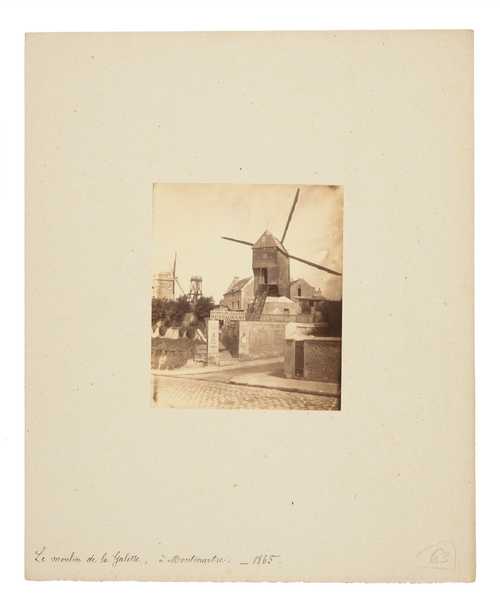
Unknown, Moulin de la Galette in Paris, albumen print, 1865
© as a collection by Jacques Herzog und Pierre de Meuron Kabinett, Basel.
17. Unknown, Moulin de la Galette in Paris, albumen print, 1865
“The Moulin de la Galette was a favorite Sunday destination of the Impressionists and their companions. They met there to eat, to drink, and to dance. One of Renoir’s best paintings captured these entertainments.
I believe the windmill is the last of its kind on Montmartre, although there had originally been many. It owes its survival to a local initiative that successfully fought its demolition in 1915.”
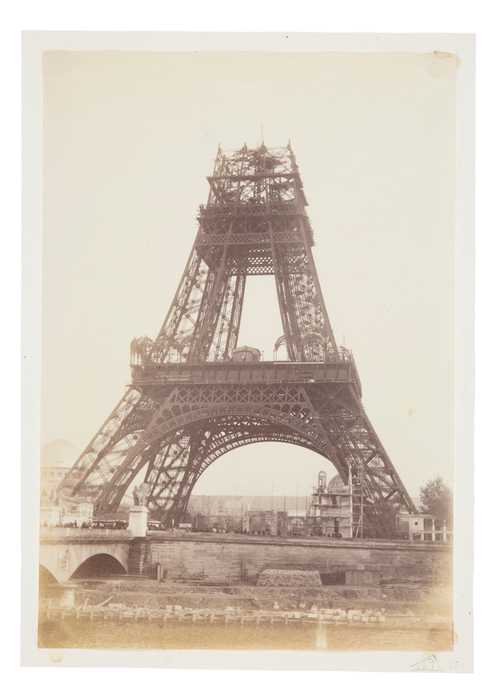
Unknown, The Eiffel Tower under construction, albumen print, 1888
© as a collection by Jacques Herzog und Pierre de Meuron Kabinett, Basel.
18. Unknown, The Eiffel Tower under construction, albumen print, 1888
“The tower designed by Gustav Eiffel for the 1889 World’s Fair was supposed to be demolished after the exhibition. Conservative circles at the time expressed concerns very similar to today’s objections to supposedly oversized buildings.
Observing the unfinished Eiffel Tower, it is impossible not to picture the structure at full size, the well-known symbol of Paris.”
19. Edouard Denis Baldus, Notre-Dame de Paris, albumen print, 1850–1860
“This calotype from the 1850s by E. D. Baldus, an early photography pioneer, shows one of the oldest sights in Paris: Notre Dame. Baldus and his colleagues documented not only the main façade. He was particularly taken by the monstrous gargoyles, using them every so often to frame the picturesque foreground for a wide view over the city. After all, with his novel The Hunchback of Notre Dame, Victor Hugo had written an impressive literary monument to the cathedral.”
Room 7
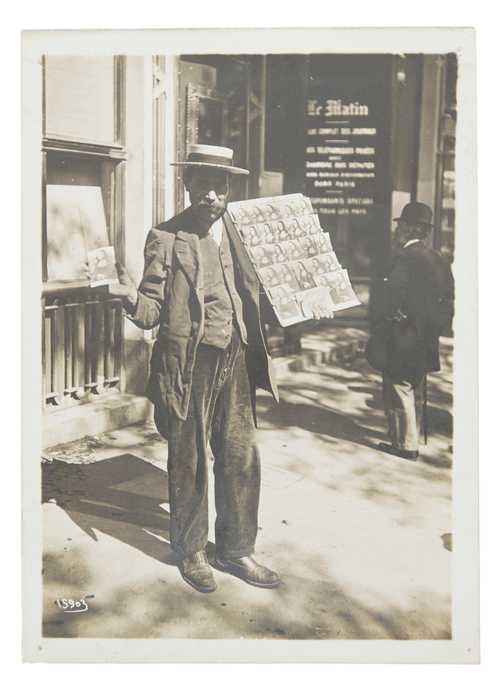
Parisian street vendor selling postcards, silver gelatin print, 1911
© as a collection by Jacques Herzog und Pierre de Meuron Kabinett, Basel.
20. Parisian street vendor selling postcards, silver gelatin print, 1911
“Some of the most interesting photos—and not just the ones in our collection—show urban street life. This young vendor is hawking postcards. Often the pictures for sale centered on current events, for example the sinking of the Titanic, or, as in this picture, the theft of the Mona Lisa from the Louvre.”
Room 8

Advertising album of a furniture store, Unknown, Advertisement for lounge furniture, chromogenic print, ca. 1950
© as a collection by Jacques Herzog und Pierre de Meuron Kabinett, Basel.
21. Advertising album of a furniture store, Unknown, Advertisement for lounge furniture, chromogenic print, ca. 1950
“If you were searching for the perfect 1950s interior for your play or film, you’d certainly find it here! After the war everything was expected to be massive. What a contrast to today! As for the album itself, it’s as clunky as the furniture on display—all of it in the wonderfully kitschy colors of the day.”

Hans Hinz, Advertisement for Knorr, Kraft-Käse (1960–1976), Roth-Händle (1967–1976), Salem No. 6, Senoussi und Fox (1952–1964), Merz + Co. AG Basel (1963), chromogenic diapositives, reproductions after the originals
© as a collection by Jacques Herzog und Pierre de Meuron Kabinett, Basel.
22. Hans Hinz, Advertisement for Knorr, Kraft-Käse (1960–1976), Roth-Händle (1967–1976), Salem No. 6, Senoussi und Fox (1952–1964), Merz + Co. AG Basel (1963), chromogenic diapositives, reproductions after the originals
“Hans Hinz hailed from Zurich but moved to Basel, a bastion of graphic designers and advertising agents.
From there, as an internationally known luminary in color photography, he was able to create outstanding advertising campaigns, for example for the Rothändle cigarette brand, working with the renowned Basel-based advertising agency GGK (Gerstner, Gredinger, Kutter).”
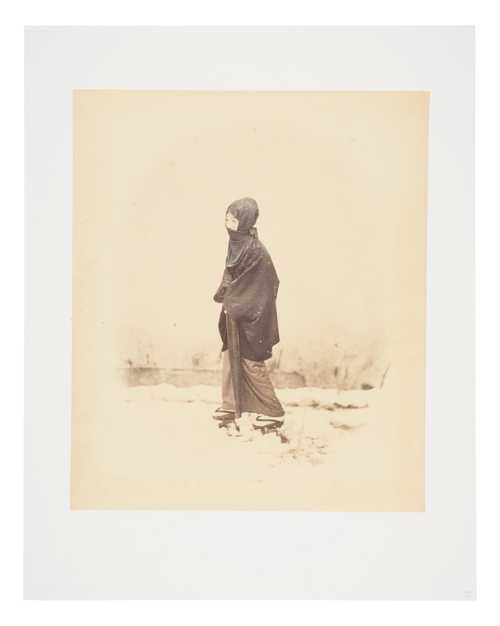
Felice Beato, Genre portraits of a Chinese man, of a Japanese woman, of day laborers, of a man in a straw rain coat and the greeting ritual before a sword training, hand-colored albumen prints, 1860–1870
© as a collection by Jacques Herzog und Pierre de Meuron Kabinett, Basel.
23. Felice Beato, Genre portraits of a Chinese man, of a Japanese woman, of day laborers, of a man in a straw rain coat and the greeting ritual before a sword training, hand-colored albumen prints, 1860–1870
“Felice Beato presents this image of a Japanese woman wrapped in her winter coat through a sort of halo, achieved by holding and refining— an oval mat over the rectangular picture during the developing process. This technique became his hallmark, making it possible today to identify his photographs, which were hardly ever signed.
This sort of genre scene was intended primarily for a non-Japanese audience, mostly Europeans and Americans. It might have been purchased individually or as part of a pre-assembled album, a portion of which always consisted of landscapes (often based on traditional woodcuts), with another portion featuring genre scenes.”
Room 9

Charles Nègre, Autoportrait in a sorcerer’s mirror, daguerreotype, ca. 1845
© as a collection by Jacques Herzog und Pierre de Meuron Kabinett, Basel.
24. Charles Nègre, Autoportrait in a sorcerer’s mirror, daguerreotype, ca. 1845
“Charles Nègre in the “witches’ mirror”: a staging of the photographer by the photographer. “Who am I?” asks Nègre (in the spirit of the Oracle of Delphi). His daguerreotype provides an answer. There are many facets to the human ego. Hence it is impossible to know (or recognize) oneself clearly. This entirely unique image is like no other in the world. In its multidimensionality it is perhaps the most meaningful work in our collection.”

Giacomo Caneva, Castel Sant’Angelo, the Basilica of St Peter and the Tiber river in Rome, salted paper print, 1845–1855
© as a collection by Jacques Herzog und Pierre de Meuron Kabinett, Basel.
25. Giacomo Caneva, Castel Sant’Angelo, the Basilica of St Peter and the Tiber river in Rome, salted paper print, 1845–1855
“Giacomo Caneva was part of a group of photographers active in Rome from quite an early date that met at the Caffè Greco. Celebrating the city in wonderful calotypes, they became the direct heirs to untold numbers of painters. Their cityscapes do not suffer in any way when compared with the finest painted veduti of Rome.”
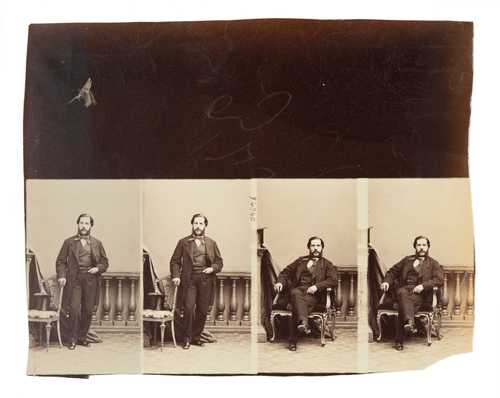
André Adolphe-Eugène Disdéri, Portraits, collage of three albumen prints, 1860–1870
© as a collection by Jacques Herzog und Pierre de Meuron Kabinett, Basel.
26. André Adolphe-Eugène Disdéri, Portraits, collage of three albumen prints, 1860–1870
“Eugène Disdéri used an eight-lensed camera for his cartes de visite, among other things. He did so here as well, making what was clearly a deliberate decision to retain the image of an insect captured during the developing process. Thus he emphasized and enhanced the fleeting moment of the act of photographing.”

Bernd und Hilla Becher, Fördertürme, Silbergelatine-Abzüge auf Barytpapier, 1967–1982
27. Bernd und Hilla Becher, Fördertürme, Silbergelatine-Abzüge auf Barytpapier, 1967–1982
“Bernd and Hilla Becher came and looked at our collection. They were of course quite interested by those pictures that struck them as forerunners to their own work. They were particularly taken with an album from 1874 documenting the newly built Paris gasworks.”
